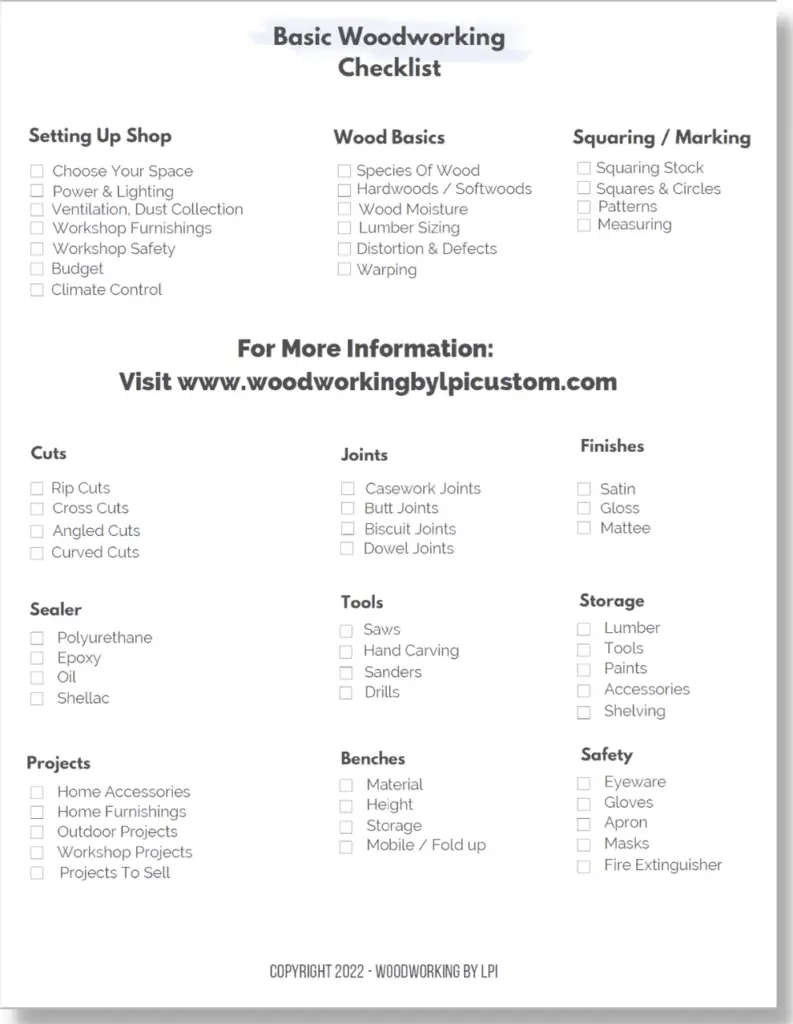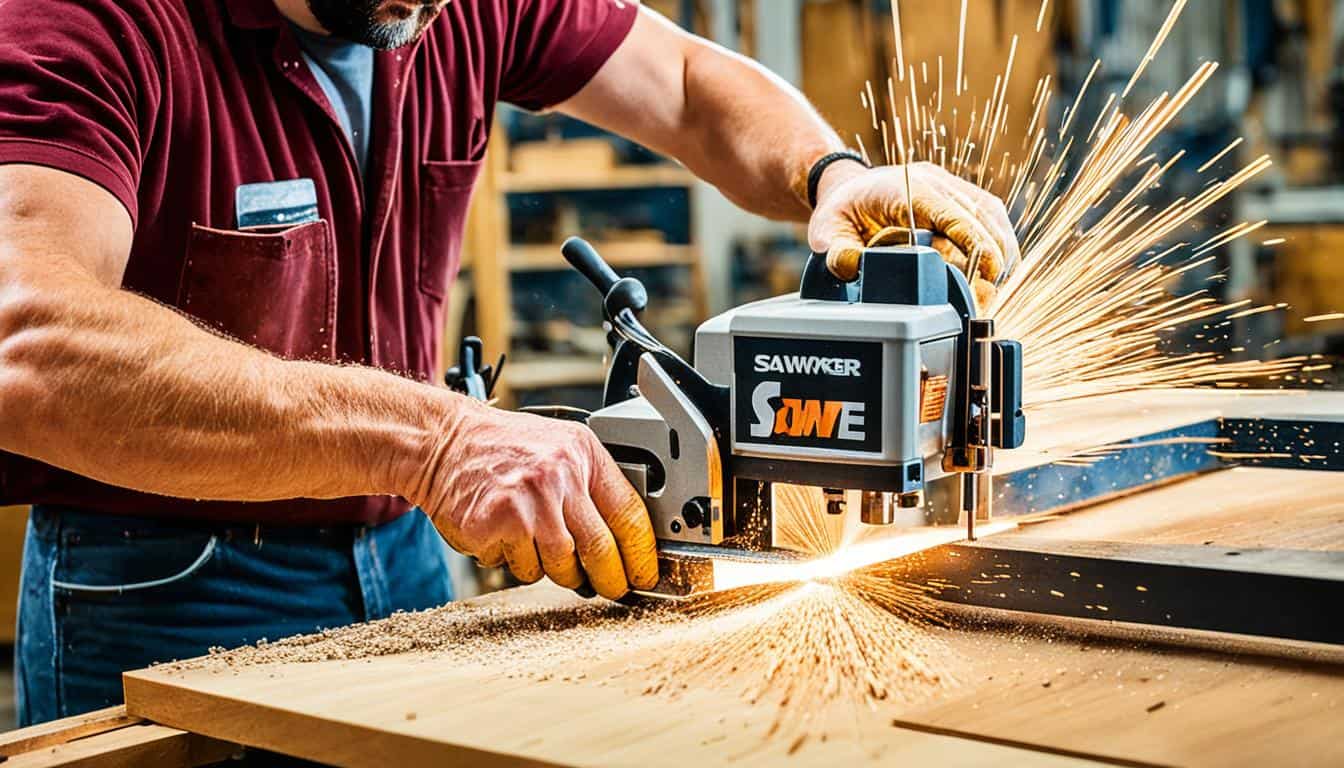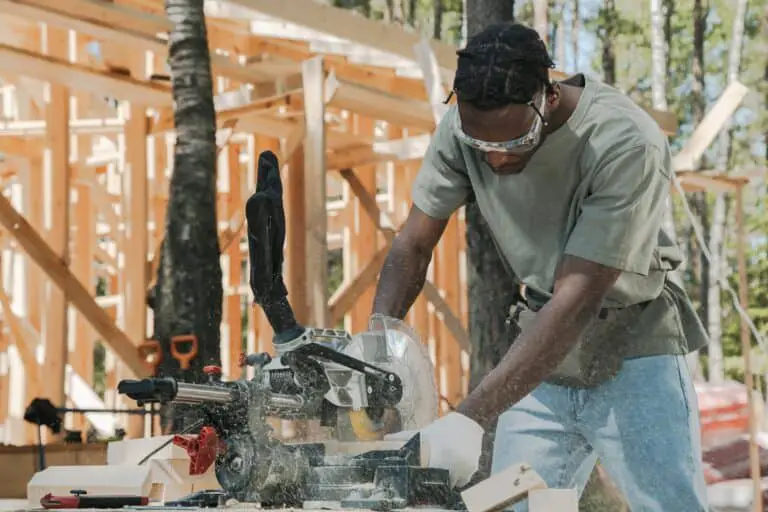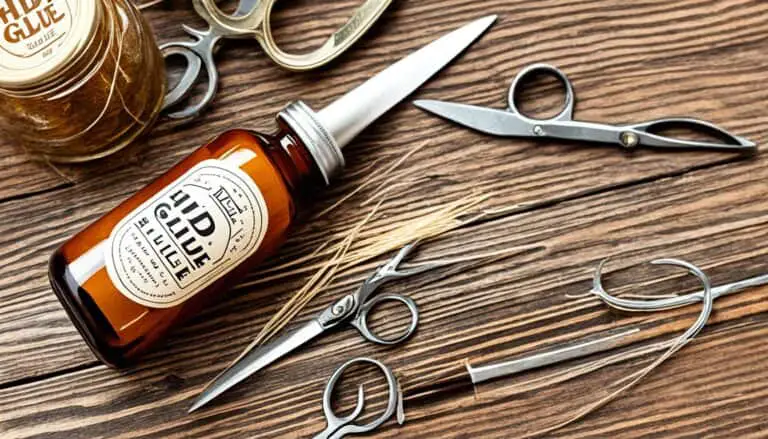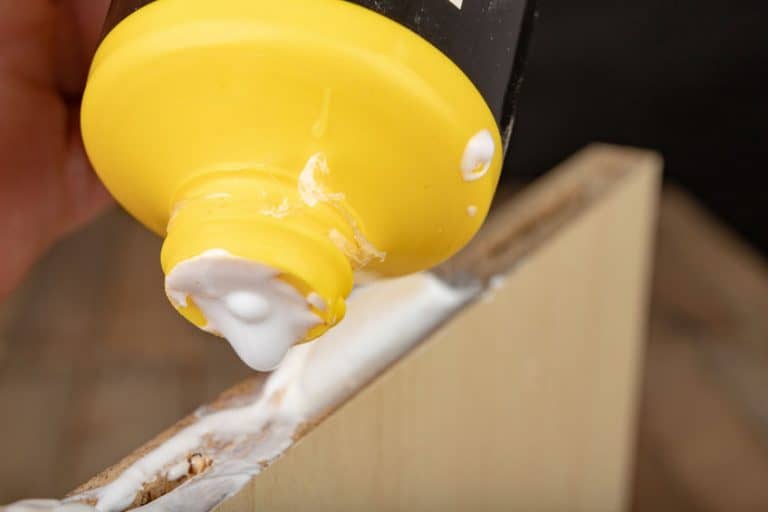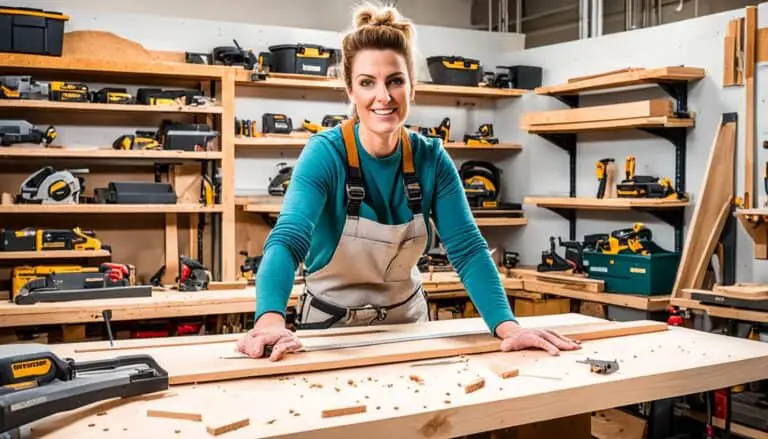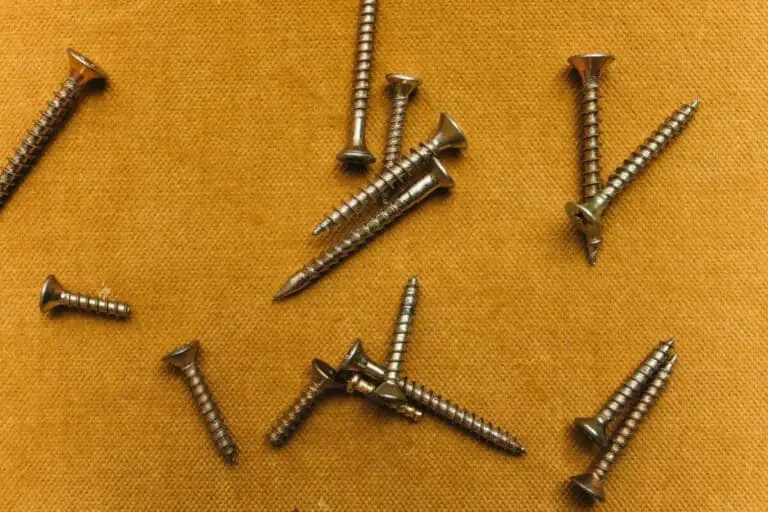Are you curious about what a band saw can be used for? Look no further! In this article, we will explore the various applications, functions, and benefits of a band saw. Whether you are a woodworking enthusiast or a metalworking aficionado, a band saw is a versatile tool that can enhance your craftsmanship and bring your projects to the next level.
A band saw is a power tool that features a continuous band of toothed metal stretched between two or more wheels. This tool is capable of making precise and intricate cuts in a variety of materials such as wood, metal, and even plastic. With its unique design and functionality, a band saw offers several advantages that make it an indispensable tool for both professional tradespeople and DIY hobbyists.
Key Takeaways:
- A band saw is a versatile tool used in woodworking, metalworking, and crafting.
- It offers precise and intricate cuts in various materials.
- Some applications of a band saw include cutting curves, ripping logs, making dovetail joints, and crafting intricate shapes.
- When choosing a band saw, consider factors such as size, power, and the type of cuts and materials you will be working with.
- Proper safety precautions and maintenance are essential for using and prolonging the life of your band saw.
Woodworking Applications of a Band Saw
In woodworking, a band saw is a valuable tool with a wide range of applications. It offers the versatility needed to make precise and intricate cuts in various materials, making it an essential tool for any woodworking enthusiast.
Cutting Curves in Delicate Materials
One of the primary uses of a band saw in woodworking is cutting curves in delicate materials. The narrow blade of a band saw allows for intricate and detailed cuts, making it ideal for creating curved designs in wood, plastic, and acrylic.
Ripping Logs into Manageable Planks
A band saw is also commonly used for ripping logs into manageable planks. The powerful motor and sharp blade make quick work of thick pieces of wood, creating smooth and consistent cuts that are essential for furniture making and other woodworking projects.
Creating Dovetail Joints
Dovetail joints are a hallmark of fine woodworking, and a band saw is an invaluable tool for creating them. With the right blade and proper technique, a band saw can make precise cuts that result in tight-fitting dovetail joints, adding strength and beauty to your woodworking projects.
Cutting Non-Ferrous Metals
While primarily used for woodworking, a band saw can also be used to cut non-ferrous metals such as aluminum, brass, and copper. With the right blade designed for cutting metal, a band saw offers the precision and control needed to make accurate cuts in these materials.
Whether you’re cutting curves, ripping logs, making dovetail joints, or working with non-ferrous metals, a band saw is a versatile tool that simplifies the process and allows you to achieve professional results in your woodworking projects.
By considering the woodworking band saw uses mentioned above, you can unlock the full potential of this versatile tool and take your woodworking skills to the next level.
Metalworking Applications of a Band Saw
In metalworking, a band saw is an indispensable tool for cutting a wide variety of metal materials with precision and efficiency. Whether you are working with metal bars, tubes, or other materials, a band saw offers a clean and accurate cutting action that allows you to create complex shapes and designs.
The band saw excels at straight cuts, allowing you to precisely slice through metal with ease. Its sharp and durable blade effortlessly cuts through the material, resulting in smooth and precise cuts. Additionally, the band saw’s adjustable blade speed and feed rate provide versatility in tackling different types and thicknesses of metal.
One of the advantages of using a band saw for metalworking is its ability to make curved cuts. By utilizing the band saw’s adjustable table and blade guides, you can create intricate curves and shapes in metal materials. This opens up a world of possibilities for artistic designs or functional metal components.
Notable Benefits of a Band Saw for Metalworking:
- Accurate cutting: The band saw’s stable and precise cutting action ensures accurate and consistent cuts in metal materials.
- Versatility: The band saw is suitable for a wide range of metalworking applications, including fabrication, sculpting, and creating prototypes.
- Efficiency: With the band saw’s efficient cutting process, you can save time and effort compared to manual cutting methods.
- Clean cuts: The band saw’s sharp blade and smooth cutting action result in clean edges, minimizing the need for additional finishing.
- Customization: The band saw allows you to easily adjust the cutting speed and angle, giving you full control over the desired outcome.
Whether you are a professional metalworker or an enthusiastic hobbyist, a band saw is a valuable addition to your workshop. Its precise cutting capabilities, versatility, and efficient performance make it an essential tool for any metalworking project.
Crafting Applications of a Band Saw
When it comes to crafting, a band saw can be a game-changer for enthusiasts and DIYers alike. Its versatility and precision make it an invaluable tool for creating intricate shapes and designs out of various materials such as wood, plastic, and acrylic.
Whether you’re a hobbyist looking to add unique details to your projects or a DIY enthusiast seeking to bring your creative ideas to life, a band saw can help you achieve your crafting goals with ease.
Cutting Intricate Shapes
One of the key advantages of using a band saw for crafting is its ability to make precise and detailed cuts. Unlike other tools, a band saw’s thin blade allows for greater control and accuracy, making it perfect for cutting intricate shapes. Whether you’re working on decorative wooden pieces or intricate designs in plastic or acrylic, a band saw can help you achieve clean, smooth edges and curves.
Personalizing Projects
A band saw can also help you personalize your crafting projects by allowing you to cut unique patterns and designs. With its blade’s versatility, you can create custom shapes and embellishments that add a personal touch to your work. From monograms to intricate filigree patterns, a band saw enables you to bring your vision to life.
Creating Layered Designs
Layered designs can add depth and dimension to your crafting projects, and a band saw is an excellent tool for achieving layered effects. By cutting multiple pieces of material with precision, you can stack and glue them together to create visually captivating designs. From detailed wooden ornaments to layered signage, a band saw gives you the freedom to experiment and create stunning layered designs.
Whether you’re a seasoned crafter or just starting your DIY journey, a band saw is a must-have tool for taking your crafting projects to the next level. With its ability to cut intricate shapes, personalize projects, and create layered designs, a band saw opens up a world of possibilities for your creative pursuits.
Importance of a Band Saw in Furniture Making
In furniture making, a band saw plays a crucial role in cutting out the various components of a piece of furniture. Its versatility and precision make it an indispensable tool for woodworking furniture projects. Whether you’re crafting a chair, table, or intricate woodwork, a band saw can help you achieve the desired results with ease.
The band saw’s ability to create curved and intricate shapes allows furniture makers to add unique design elements to their pieces. From ornate patterns to smooth contours, the band saw enables the creation of intricate details that enhance the overall aesthetics of the furniture.
With a band saw, furniture makers can work with a wide range of materials, including solid wood, plywood, and laminates. The band saw’s adjustable blade tension and cutting speed allow for precise and clean cuts, minimizing wastage and ensuring efficient use of materials.
Using a band saw in furniture making brings your vision to life. Its versatility and accuracy allow you to create furniture pieces that are not only functional but also showcase your craftsmanship and artistic expression.
The Band Saw Advantage
By incorporating a band saw into the furniture making process, you can:
- Create curved and intricate designs: The band saw’s maneuverability and adjustable blade allow for precise cutting of complex shapes, enabling you to achieve unique furniture designs.
- Improve efficiency: With its ability to cut through different materials seamlessly, the band saw speeds up the production process, making furniture making more efficient.
- Enhance precision: The band saw’s stable and accurate cutting action ensures clean edges and tight joints, resulting in furniture pieces that fit together flawlessly.
- Reduce manual labor: Compared to traditional hand tools, a band saw significantly reduces the physical effort required in cutting and shaping furniture components, saving both time and energy.
By harnessing the power of a band saw in furniture making, you can elevate your craft and create pieces that stand out with their intricate details and impeccable craftsmanship.
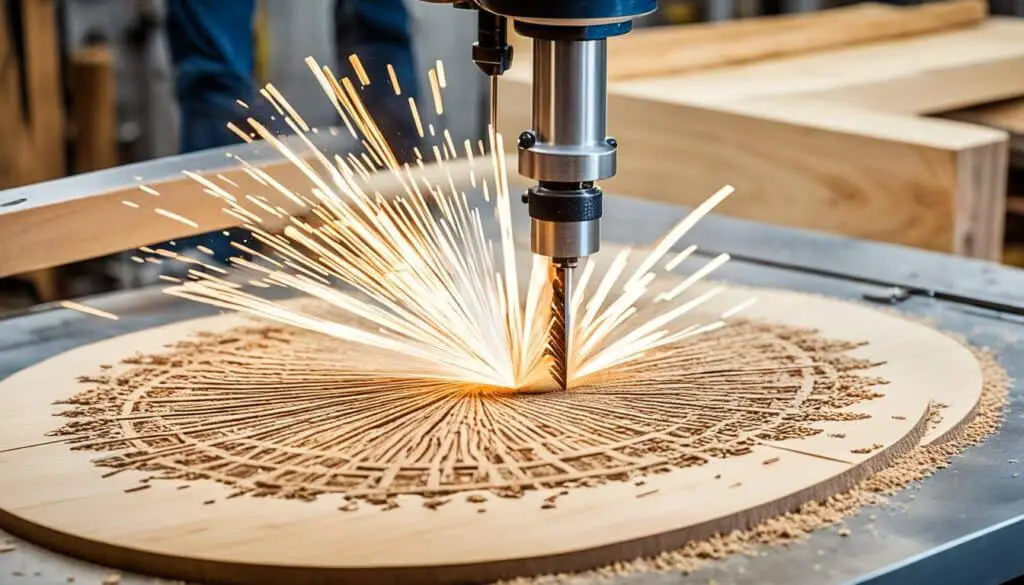
Benefits of Using a Band Saw
A band saw offers numerous advantages, making it a valuable tool in any workshop. Whether you’re a woodworker, metalworker, or crafting enthusiast, using a band saw can greatly enhance your cutting capabilities and improve the quality of your projects. Let’s explore the benefits of using a band saw:
Versatility in Cutting Different Materials
One of the key advantages of a band saw is its versatility in cutting various materials. Whether you’re working with wood, metal, plastics, or acrylic, a band saw can handle it all. With the right blade, you can achieve clean and precise cuts on different materials, allowing you to tackle a wide range of projects with ease.
Precise and Intricate Cuts
A band saw excels at making precise and intricate cuts. Its narrow blade and adjustable cutting speed offer greater control and accuracy compared to other cutting tools. Whether you need to cut curves, angles, or intricate shapes, a band saw allows for detailed craftsmanship and finer finishes.
Efficiency in Woodworking and Metalworking Tasks
A band saw is designed to handle various woodworking and metalworking tasks with efficiency. It can rip logs into planks, create dovetail joints, cut non-ferrous metals, and more. The band saw’s ability to make straight cuts and navigate tight curves makes it an essential tool for both precise and efficient work.
| Advantages of Using a Band Saw | Benefits |
|---|---|
| Versatility in cutting different materials | Allows for a wider range of projects |
| Precise and intricate cuts | Enhances craftsmanship and finishes |
| Efficiency in woodworking and metalworking tasks | Improves productivity and accuracy |
High Level of Control and Accuracy
A band saw provides a high level of control and accuracy during the cutting process. The ability to adjust the blade tension, cutting speed, and blade tracking allows you to achieve the desired results with minimal effort. This control and precision make the band saw an indispensable tool for professionals and hobbyists alike.
When it comes to cutting materials with precision and versatility, a band saw is a tool you can rely on. Its ability to handle various materials, make intricate cuts, and improve efficiency in woodworking and metalworking tasks makes it a must-have for any workshop.
Choosing the Right Band Saw for Your Needs
When it comes to finding the perfect band saw for your woodworking or metalworking projects, there are several factors to consider. By understanding your specific needs and requirements, you can make an informed decision that will result in a tool that enhances your craftsmanship and productivity.
Size and Power
The first thing to think about is the size of the band saw. Band saws come in various sizes, from compact benchtop models to large floor-standing machines. Consider the available space in your workshop and the dimensions of the materials you typically work with to determine the right size for your needs.
Tip: Measure the size of your workspace and check the maximum cutting capacity of the band saw to ensure compatibility.
Additionally, think about the power of the band saw. More powerful motors allow for smoother cuts and better performance, especially when working with dense or hard materials. Evaluate the power requirements of your projects to select a band saw with the appropriate horsepower.
Type of Cuts and Materials
Next, consider the type of cuts you will be making with the band saw. Band saws are versatile tools that can handle straight cuts, curved cuts, and even intricate designs. Determine the complexity of your projects and choose a band saw that offers the necessary features and capabilities.
Furthermore, take into account the materials you will be working with. Band saws can cut various materials, including wood, metal, and plastic. Ensure that the band saw you choose is specifically designed for the materials you frequently use, as different blades and features may be required for optimal results.
Quality and Reputation
Finally, consider the overall quality and reputation of the brand. Invest in a band saw from a reputable manufacturer known for producing reliable and durable tools. Look for customer reviews and ratings to gain insights into the performance and longevity of the band saws you’re considering.
Tip: Research well-known band saw brands such as Delta, Jet, Dewalt, Rikon, and Grizzly to find high-quality options.
By carefully considering the size, power, type of cuts, materials, and reputation of the brand, you can confidently choose the right band saw for your needs. Remember to prioritize your specific requirements and preferences to find a band saw that will enhance your woodworking or metalworking endeavors.
Tips for Using a Band Saw Safely
When using a band saw, it is crucial to prioritize safety to prevent accidents or injuries. By following these band saw safety tips and precautions, you can ensure a safe and productive woodworking experience.
1. Wear Proper Safety Gear
Always wear the appropriate safety gear when using a band saw. This includes safety glasses or goggles to protect your eyes from flying debris, gloves to keep your hands safe, and ear protection to minimize noise exposure.
2. Keep Hands and Fingers Away from the Blade
Avoid placing your hands or fingers near the blade while the band saw is in operation. Maintain a safe distance from the blade, using push sticks or other tools to guide the material through the cut instead.
3. Secure the Material Properly
Ensure that the material you are cutting is firmly secured in place before starting the band saw. This will prevent it from slipping, reducing the risk of accidents.
4. Use the Correct Blade for the Cut
Choose the appropriate blade for the type of cut you are making. Different blade types and tooth configurations are designed for specific materials and cutting techniques. Refer to the manufacturer’s recommendations for guidance.
5. Maintain a Safe Working Area
Keep your work area clean and organized to minimize the risk of accidents. Remove any obstacles and debris that could interfere with your work or cause injuries.
“Remember: safety should always be your top priority when using a band saw. By following proper safety precautions, you can enjoy the benefits of this powerful tool while minimizing the risk of accidents.”
Remember: safety should always be your top priority when using a band saw. By following proper safety precautions, you can enjoy the benefits of this powerful tool while minimizing the risk of accidents.
Maintenance and Care for Your Band Saw
To ensure the longevity and performance of your band saw, proper maintenance and care are essential. By following these band saw maintenance tips, you can keep your tool in excellent condition and maximize its efficiency.
Cleaning the Band Saw
Regular cleaning is crucial to prevent dust and debris buildup that can affect the saw’s performance. After each use, take the time to clean the saw thoroughly. Remove any sawdust, chips, or other materials from the table, blade, guides, and other parts of the saw. Use a brush or vacuum to remove loose debris, and wipe down the surfaces with a clean, dry cloth.
Checking and Adjusting Blade Tension
Proper blade tension is essential for achieving accurate cuts. Regularly check the tension of the blade and make any necessary adjustments. Use a tension gauge to ensure that the blade is tightened to the manufacturer’s recommended specifications. Adjust the tension according to the type of material you will be cutting.
Lubricating Moving Parts
To keep the band saw running smoothly, it is important to lubricate the moving parts. Apply a high-quality lubricant to the blade guides, wheels, and any other parts that require lubrication. This will help reduce friction and ensure optimal performance.
Inspecting for Wear or Damage
Regular inspections are necessary to identify any signs of wear or damage. Check the blade for any cracks, dullness, or missing teeth. Inspect the guides, wheels, and other components for any excessive wear or misalignment. If you notice any issues, address them immediately to prevent further damage and maintain the safety of your band saw.
| Maintenance Task | Frequency |
|---|---|
| Cleaning the band saw | After each use |
| Checking and adjusting blade tension | Regularly or as needed |
| Lubricating moving parts | Regularly or as recommended by the manufacturer |
| Inspecting for wear or damage | Regularly or before each use |
By incorporating these band saw maintenance tips into your routine, you can keep your tool in optimal condition and ensure its longevity. Remember to also refer to the manufacturer’s guidelines for specific maintenance instructions and recommendations.
Popular Band Saw Brands
When it comes to purchasing a band saw, choosing a reliable and reputable brand is essential. Here are some of the top band saw brands known for manufacturing high-quality and durable band saws:
- Delta: Delta is a well-established brand in the woodworking industry, offering a wide range of band saws suitable for both beginners and professionals.
- Jet: Jet is known for its precision and reliability, producing band saws that deliver excellent performance and accuracy for woodworking and metalworking projects.
- Dewalt: Dewalt is a trusted name in the power tool industry, and their band saws are no exception. These band saws are designed with durability and versatility in mind.
- Rikon: Rikon offers a variety of band saw models that cater to different needs and budgets. Their band saws are known for their smooth operation and precise cutting capabilities.
- Grizzly: Grizzly manufactures a wide range of band saws, including both benchtop and floor-standing models. These band saws are built to withstand heavy use and deliver consistent results.
When considering these top band saw brands, you can be confident that you are investing in a reliable and durable tool that will meet your woodworking, metalworking, or crafting needs. Remember to choose a band saw model that aligns with your specific requirements and project goals.
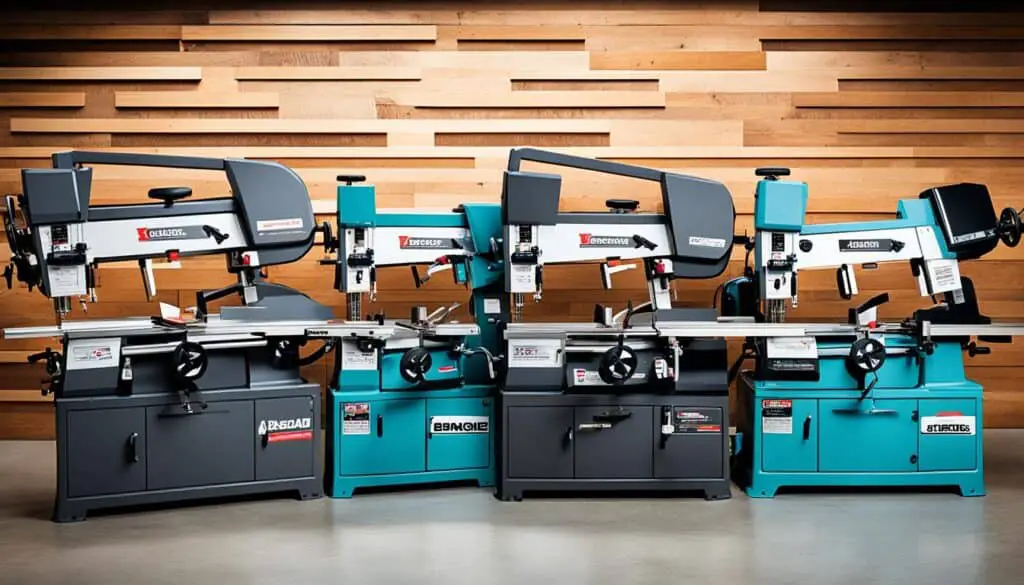
| Brand | Special Features | Price Range | Customer Ratings |
|---|---|---|---|
| Delta | Easy-to-use controls, sturdy construction | $300 – $1,500 | 4.5/5 |
| Jet | Precision cutting, advanced safety features | $500 – $2,000 | 4.7/5 |
| Dewalt | Portability, quick blade changes | $400 – $1,200 | 4.4/5 |
| Rikon | Smooth operation, adjustable speed settings | $400 – $1,500 | 4.6/5 |
| Grizzly | Powerful motors, large cutting capacity | $500 – $2,500 | 4.8/5 |
Key Takeaways:
When it comes to choosing a band saw, selecting a reputable brand is crucial for ensuring quality and performance. Delta, Jet, Dewalt, Rikon, and Grizzly are among the top band saw brands known for their reliable and durable products. Consider the special features, price range, and customer ratings when comparing these brands to find the band saw that best suits your woodworking or metalworking needs.
Accessories and Attachments for Band Saws
Band saws are versatile tools that can be further enhanced with the use of various accessories and attachments. These additions can help broaden the functionality and increase the precision of your band saw, allowing you to tackle a wider range of projects with ease.
Here are some commonly used band saw accessories and attachments:
Miter Gauge
A miter gauge is a handy accessory that allows you to make angled cuts with precision. It features a guide and adjustable stops, enabling you to set the desired angle and maintain consistent and accurate cuts. Whether you’re working on furniture pieces or intricate inlay designs, a miter gauge is a valuable tool that helps you achieve professional results.
Rip Fence
A rip fence is an essential accessory for making straight and parallel cuts. It ensures that your workpiece remains aligned and stable during the cutting process, resulting in clean and uniform edges. With a rip fence, you can effortlessly cut long pieces of wood or create repetitive cuts without compromising accuracy.
Band Saw Blade Guides
Band saw blade guides play a crucial role in maintaining blade stability and minimizinge blade drift. They consist of bearings or blocks that provide support and control the blade’s movement, allowing for smoother and more precise cuts. With properly adjusted blade guides, you can achieve cleaner cuts and reduce the risk of blade damage or premature wear.
These are just a few examples of the many accessories and attachments available for band saws. Depending on your specific needs and projects, there are additional options such as circle cutting jigs, resaw fences, and dust collection systems that can further enhance your band saw’s capabilities.
Remember to choose accessories and attachments that are compatible with your band saw model and ensure they are properly installed and adjusted for optimal performance.
Tips for Getting the Most Out of Your Band Saw
To get the best results with your band saw, it’s important to follow some tips and tricks that will help you maximize its performance. By utilizing the right techniques and adopting best practices, you can achieve precise cuts and improve your overall woodworking experience. Here are some valuable tips to help you get the most out of your band saw:
- Choose the right blade: Selecting the appropriate blade for your specific material and cut is crucial for optimal performance. Different blades are designed for different purposes, so take the time to understand their variations and choose the one that suits your needs best.
- Maintain proper blade tension: Maintaining the correct blade tension is essential for achieving accurate and clean cuts. Ensure that the blade tension is within the manufacturer’s recommended range to avoid blade drift and maximize cutting efficiency.
- Use the proper feed rate: Controlling the feed rate of the material through the blade is important for achieving smooth cuts. Too fast or too slow of a feed rate can result in poor quality cuts and excessive blade wear. Experiment with different feed rates to find the optimal speed for your specific project.
- Keep the band saw clean: Regularly cleaning your band saw helps maintain its performance and longevity. Remove sawdust and debris from the table, guides, and wheels to prevent interference with the blade and ensure smooth operation.
- Check and adjust the blade tracking: Periodically check the blade tracking to ensure it is perfectly aligned on the top and bottom wheels. Adjust the tracking as necessary to avoid blade slippage and ensure precise cuts.
- Invest in quality accessories: Using the right accessories can greatly enhance your band saw’s capabilities. Consider investing in accessories such as a miter gauge or rip fence to improve accuracy and control during cuts.
- Practice and experiment: Like any skill, mastering the band saw requires practice and experimentation. Take the time to familiarize yourself with different cutting techniques and materials. With regular practice, you’ll gain confidence and improve your band saw skills.
By following these tips, you’ll be able to maximize the performance of your band saw and achieve the best possible results. Remember to always prioritize safety when working with any power tool. Happy sawing!
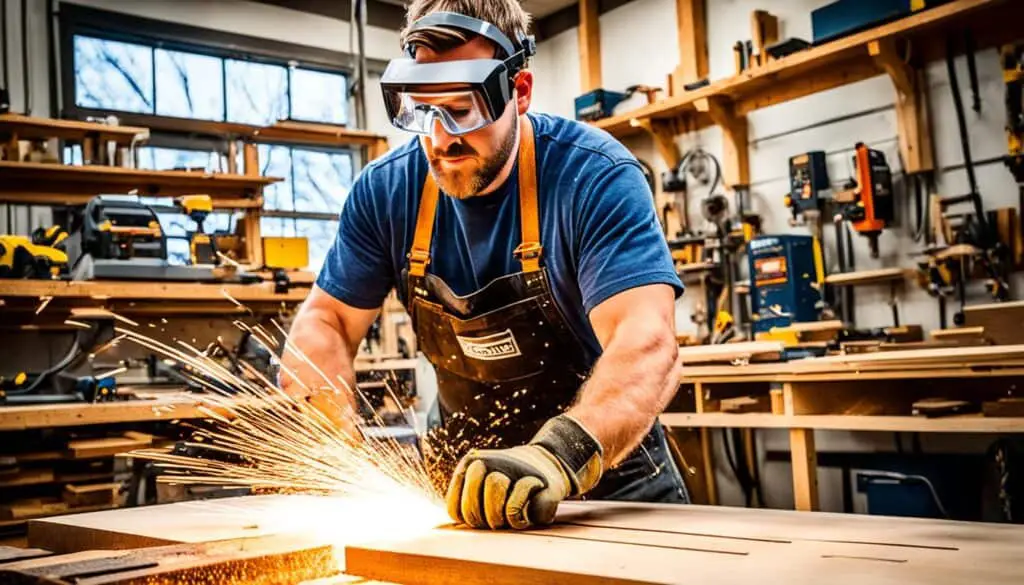
Troubleshooting Common Band Saw Issues
Band saws, like any other tools, can sometimes encounter issues or problems that affect their performance. Understanding and troubleshooting these common band saw problems can help you fix them and ensure optimal operation. Here are a few common band saw issues and how to address them:
1. Blade Drift
Blade drift occurs when the saw blade tends to veer off course during a cut, resulting in inaccurate cuts. To fix blade drift:
- Check the blade tension and make sure it is properly set.
- Ensure the blade guides and bearings are properly adjusted and properly aligned.
- Inspect the blade for any damage or dullness and replace if necessary.
2. Cutting Inaccuracies
If you notice that your band saw is producing inconsistent or inaccurate cuts, consider the following troubleshooting steps:
- Check the blade tension and adjust it as needed.
- Inspect the blade guides and bearings for any misalignment or damage.
- Ensure the workpiece is securely positioned and properly supported during the cut.
- Verify that the fence or miter gauge is properly aligned.
3. Blade Breakage
Blade breakage can occur due to various reasons, including excessive tension, improper blade installation, or using the wrong blade for the material being cut. Here’s how you can address this problem:
- Check the blade tension and make sure it is within the recommended range for the specific blade.
- Ensure the blade is properly installed, with the teeth facing the right direction.
- Select the appropriate blade for the material and cut you are performing.
By following these troubleshooting steps, you can resolve common band saw problems and ensure smooth and accurate cutting. Remember to always refer to your band saw’s user manual for specific troubleshooting instructions.
| Common Band Saw Issues | Troubleshooting Steps |
|---|---|
| Blade Drift | 1. Check blade tension 2. Adjust blade guides 3. Inspect and replace blade |
| Cutting Inaccuracies | 1. Check blade tension 2. Inspect and adjust blade guides 3. Securely position and support workpiece 4. Align fence or miter gauge |
| Blade Breakage | 1. Check blade tension 2. Ensure proper blade installation 3. Select appropriate blade for the material |
Benefits of Band Saw Training and Education
Taking the time to undergo band saw training or education can greatly enhance your skills and knowledge in using a band saw. It goes beyond simply reading manuals or watching online tutorials; formal training provides structured learning and hands-on experience that can significantly elevate your expertise.
Band saw training equips you with the necessary foundation to operate the tool safely and effectively. You’ll learn the proper techniques for handling the band saw, minimizing the risk of accidents or injuries. Safety protocols will be emphasized, ensuring that you understand how to use the machine correctly and protect yourself from potential hazards.
Moreover, band saw education goes beyond basic operations by delving into advanced cutting methods and strategies. You’ll gain insights into optimizing the tool’s capabilities and leveraging specific features for different materials and applications. This knowledge empowers you to tackle complex projects with confidence and achieve exceptional results.
Band saw training and education open up a world of possibilities for exploring new applications and projects. By expanding your skills, you can take on challenging woodworking, metalworking, or crafting endeavors that were previously beyond your capabilities. Whether it’s creating intricate designs or crafting custom furniture pieces, the band saw becomes a versatile tool in your workshop.
Continuous learning and improvement are key to honing your craft. Band saw training and education offer the opportunity to collaborate with experts in the field, network with fellow enthusiasts, and gain valuable insights from their experiences. Workshops and courses provide a supportive environment for skill development, ensuring that you stay up to date with the latest techniques and industry trends.
Investing in band saw training and education is an investment in your own growth as a woodworker, metalworker, or crafter. It equips you with the knowledge and confidence to tackle new challenges, take on more complex projects, and produce exceptional results. Whether you’re a beginner or an experienced user, there is always more to learn and discover with band saws.
| Benefits of Band Saw Training and Education |
|---|
| Enhanced skills and knowledge in using a band saw |
| Learn proper techniques and safety precautions |
| Explore advanced cutting methods |
| Opportunity to tackle complex projects |
| Collaborate with experts and gain valuable insights |
| Continuous learning and personal growth |
Conclusion
In conclusion, the band saw is a versatile and indispensable tool in woodworking, metalworking, and crafting. Its wide range of applications and functions make it an essential asset in any workshop. Whether you need to cut intricate curves in delicate materials or rip logs into manageable planks, the band saw offers precise and detailed cuts in various materials.
By understanding the uses and benefits of a band saw, you can make informed decisions when selecting, using, and maintaining this tool. Its ability to cut various materials with accuracy and efficiency makes it a valuable investment for woodworking, metalworking, and crafting projects. The band saw’s versatile functionality enables it to handle different tasks, making it an essential tool for DIY enthusiasts, hobbyists, and professionals alike.
With its exceptional cutting capabilities, the band saw empowers you to create unique and beautiful designs in furniture making, whether you’re cutting intricate shapes or creating curved components. It allows you to make precise cuts in metal bars, tubes, and other materials, ensuring clean and accurate results in your metalworking projects. Additionally, the band saw is instrumental in crafting projects, enabling you to easily cut intricate shapes and designs in materials such as wood, plastic, and acrylic.
In summary, the band saw’s versatility, precision, and efficiency make it an invaluable tool for a wide range of applications in woodworking, metalworking, and crafting. By understanding its numerous uses and functions, you can harness the full potential of the band saw, enabling you to achieve exceptional results in your projects and maximize your productivity in the workshop.
FAQ
What is a band saw used for?
A band saw is a versatile tool that can be used for a wide range of woodworking, metalworking, and crafting tasks. It is commonly used for cutting curves in delicate materials, ripping logs into planks, making dovetail joints, cutting metal bars and tubes, and cutting intricate shapes and designs out of various materials.
What are the woodworking applications of a band saw?
In woodworking, a band saw is used for cutting curves in delicate materials, ripping logs into manageable planks, making dovetail joints, and cutting intricate shapes and designs. It allows for precise and intricate cuts in various materials.
What are the metalworking applications of a band saw?
In metalworking, a band saw is used for cutting metal bars, tubes, and other materials. It offers a clean and precise cutting action, making it ideal for creating accurate shapes and designs in metal.
What are the crafting applications of a band saw?
For crafting purposes, a band saw is useful for cutting intricate shapes and designs out of various materials such as wood, plastic, and acrylic. It allows for precise and detailed cuts, making it a popular tool for hobbyists and DIY enthusiasts.
What is the importance of a band saw in furniture making?
In furniture making, a band saw plays a crucial role in cutting out the various components of a piece of furniture. It allows for the creation of curved and intricate shapes, making it easier to achieve unique and beautiful designs in furniture.
What are the benefits of using a band saw?
Some key benefits of using a band saw include its versatility in cutting different materials, its ability to make precise and intricate cuts, and its efficiency in handling various woodworking and metalworking tasks. It offers a high level of control and accuracy, making it a valuable tool in any workshop.
How do I choose the right band saw for my needs?
When choosing a band saw, it is important to consider factors such as the size and power of the saw, the type of cuts you will be making, and the materials you will be working with. It is also important to consider the overall quality and reputation of the brand.
What are the tips for using a band saw safely?
When using a band saw, it is important to follow proper safety precautions to avoid accidents or injuries. This includes wearing appropriate safety gear, such as safety glasses and gloves, and taking care to keep your hands and fingers away from the blade.
How do I maintain and care for my band saw?
To ensure the longevity and performance of your band saw, regular maintenance and care are necessary. This includes cleaning the saw, checking and adjusting the blade tension, and lubricating moving parts. It is also important to regularly inspect the saw for any signs of wear or damage.
What are some popular band saw brands?
Some popular band saw brands include Delta, Jet, Dewalt, Rikon, and Grizzly. These brands are known for producing high-quality band saws that are reliable and durable. It is important to choose a reputable brand when purchasing a band saw to ensure its quality and performance.
What are some accessories and attachments for band saws?
There are various accessories and attachments available for band saws that can enhance their functionality and versatility. Some common accessories include a miter gauge, rip fence, and band saw blade guides. These additions can help improve the precision and accuracy of cuts made with a band saw.
What are some tips for getting the most out of a band saw?
To get the most out of your band saw, it is important to practice proper techniques and follow best practices. This includes using the appropriate blade for the material and cut, maintaining the correct blade tension, and using the proper feed rate. Regular practice and experimentation can help improve your skills with a band saw.
How do I troubleshoot common band saw issues?
Like any tool, band saws can encounter issues or problems. Some common band saw issues include blade drift, cutting inaccuracies, and blade breakage. By understanding these common issues and learning how to troubleshoot them, you can ensure the optimal performance of your band saw.
What are the benefits of band saw training and education?
Taking the time to undergo band saw training or education can greatly enhance your skills and knowledge in using a band saw. It can help you learn proper techniques, safety precautions, and advanced cutting methods. Additionally, training can provide you with the opportunity to explore new applications and projects with a band saw.

